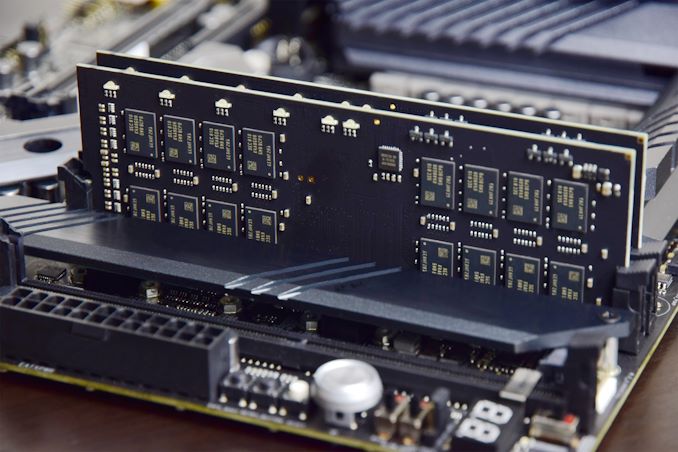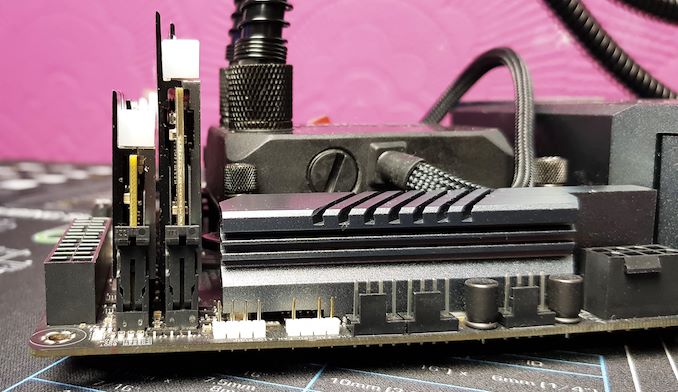Double Height DDR4: 32GB Modules from G.Skill and ZADAK Reviewed
by Ian Cutress & Gavin Bonshor on January 23, 2019 9:00 AM EST
Two memory module companies, G.Skill and ZADAK, have developed a new memory format with double capacity DDR4 memory. These new modules put the equivalent of two standard modules onto one PCB, making one memory module act like two. Both companies have introduced 2x32 GB kits. As a result, these memory modules are double the capacity over regular DDR4 memory, with the downside that they are also double the height. We have tested both of the available kits using this technique, both coming in at DDR4-3200: the G.Skill TridentZ RGB DC DDR4-3200 and the ZADAK Shield RGB DC DDR4-3200.
Double Height Memory?
One of the disadvantages of small form factor motherboards is that they only feature two memory slots. Most consumer DDR4 modules can have a maximum capacity of 16 GB per module, which for mini-ITX would mean a maximum capacity of 32 GB. For ATX motherboards, this usually means a maximum capacity of 64 GB. Users looking to build those small form factor systems have historically been capped to 32 GB - these new modules doubles that capacity to 64 GB.
There are currently three motherboards on the market validated for this new double height memory:
- ASUS ROG Maximus XI Apex (Z390)
- ASUS ROG Maximus XI Gene (Z390)
- ASUS ROG Strix Z390-I Gaming
These are all Z390 chipset motherboards, and thus applies to Intel's 8th Gen and 9th Gen processors. In this review we used an i7-8700K, and it didn't have any issues. We tested on some other motherboards from MSI and ASRock, however those systems did not post. It would appear that the memory has been developed in conjuction with concurrent validation with ASUS.

Left to Right: ZADAK Shield RGB DC, G.Skill TridentZ RGB DC,
G.Skill TridentZ RGB & Corsair Vengeance LPX
Each memory company is only offering a select number of kits, presumably due to the low catchment rate of the motherboards they are validated for, but also likely due to cost.
G.Skill is offering three different 'TridentZ RGB DC' memory kits, each 2x32 GB:
- G.Skill TridentZ RGB DC DDR4-3000 CL14
- G.Skill TridentZ RGB DC DDR4-3200 CL14
- G.Skill TridentZ RGB DC DDR4-3200 CL14 (looser secondary latencies)
ZADAK by contrast is offering five 'Shield RGB DC' memory kits, each 2x32 GB:
- ZADAK Shield RGB DC DDR4-2666 CL16
- ZADAK Shield RGB DC DDR4-3000 CL16
- ZADAK Shield RGB DC DDR4-3200 CL16
- ZADAK Shield RGB DC DDR4-3200 CL14
- ZADAK Shield RGB DC DDR4-3600 CL16
All of these kits (except ZADAK's DDR4-2666) have a rated voltage of 1.35 V. G.Skill's kits do not have associated MSRPs due to the way G.Skill operates, however ZADAK has shared that their memory kits will start from an MSRP of $800.
The benefit of dense(r) memory is thatmotherboards can double up on maximum capacity without needing four memory slots. All three motherboards listed, the Apex, Gene, and the Z390-I Gaming, only have two memory slots which makes them ideal targets, even though only one is mini-ITX and the other two could have had four memory slots in place. The reason why only these ASUS motherboards are supported at this time is due to the collaboration between the companies: ZADAK says the modules were 'co-developed', but failed to go into detail about who designed what. Nonetheless, these modules are ASUS exclusive for the time being.
Double Height: Cooler Selection
Using memory that is double the height of a normal module, certain other restrictions come into play: namely the CPU cooler being used has less room to exist.
The almost universal intention in this environment, unless a low powered CPU is used, is for a liquid cooler to be in play.
Under The Heatsinks
We'll go into more detail on the specific kits over the page, but both memory modules work in a similar fashion.
Using 8 Gb Samsung B-die chips, a normal 16 GB module would have 16 of them to make it up to capacity. For these modules, to reach 32 GB per module, there are 32 x 8 gigabit chips. These are split into two ranks of sixteen chips, and act as if there are two memory modules on the same channel. Modern mainstream processors support 'two DIMMs per channel', meaning two memory modules per channel, which is why we see motherboards for dual channel processors have a total of four slots. By putting two modules onto one PCB, only one slot is needed to hit 'two DIMMs per channel'.
One would assume the signalling would be different, however within the same channel, a normal set of memory modules would use the same traces and either (a) daisy chain, or (b) split near the end in order to support both simulateously. There are stability advantages to the (b) method, known as T-Topology, however it is often more difficult to do. Either way, because two memory modules on the same channel do not need separate motherboard traces, that is what makes these modules possible. There are some additional fine tuning elements to the system as well, as with all memory.
Ultimately any memory vendor's chips could have been used, but both G.Skill and ZADAK have gone with Samsung B-die, which are known for being good overclocking-focused memory. It likely also helps that the optimizations for one company's kit also helped with the second, as different ICs would have different requirements in the firmware.
Ultimately with this review, we want to answer the following questions:
- Is there any performance difference against normal 16GB modules, and
- How is the power draw affected?
The goal for both answers should be negative: we shouldn't expect any performance difference and no power difference. We also do some overclocking to see if they can be pushed harder even in this form factor.
Test Bed and Methodology
| Test Setup | |||
| Processor | Intel i7-8700K, 95W, $359 / 1ku 6 Cores, 12 Threads, 3.7 GHz (4.7 GHz Turbo) |
||
| Motherboard | ASUS ROG Strix Z390-I Gaming (BIOS Version 1003) | ||
| Cooling | Corsair H100i V2 | ||
| Power Supply | Thermaltake Toughpower Grand 1200W Gold PSU | ||
| Memory Tested | 2x32GB G.Skill TridentZ DC RGB DDR4-3200 CL14 (1.35 V) 2x32GB ZADAK Shield DC RGB DDR4-3200 CL14 (1.35 V) 2x16GB G.Skill TridentZ RGB DDR4-3200 CL14 (1.35 V) 2x16GB Corsair Vengeance LPX DDR4-2400 CL14 (1.2 V) 2x8GB TeamGroup Night Hawk RGB DDR4-3000 CL16 (1.35 V) |
||
| Video Card | ASUS GTX 980 STRIX (1178/1279 Boost) | ||
| Hard Drive | Crucial MX300 1TB | ||
| Case | Open Test Bed | ||
| Operating System | Windows 10 RS3 inc. Spectre/Meltdown Patches | ||
New Test Suite: Spectre and Meltdown Hardened
Our motherboard benchmarking suite which includes our short form CPU performance tests and gaming tests were selected in conjunction with our new 2019 bench suite. Our test bench OS has been updated with drivers, newer software and as with our CPU testing updates, also includes Spectre and Meltdown patches.
Pages In This Review
- Double Capacity, Double Height RAM [this page]
- G.Skill TridentZ RGB DC Overview: Analysis of the Board Components
- ZADAK Shield RGB DC Aura2 Overview : Looking that the non-hardware portion
- CPU Performance
- Gaming Performance
- Power Analysis
- Overclocking Performance
- Conclusion












50 Comments
View All Comments
mickulty - Wednesday, January 23, 2019 - link
Really interesting article, thanks Gav and Ian!I'd love to see how a configuration using these DC sticks compares to 4x16GB on a 4-dimm T-topology board, especially in ability to hit higher speeds.
edzieba - Wednesday, January 23, 2019 - link
Presumably the "Two DIMMs One Channel"-on-a-board layout would preclude these being used in 4-slot consumer boards (which would require effectively 4 DIMMs per channel)? I can't think of any boards off the top of my head that support more than 2 DIMMs per channel without using FBDIMMs.Ej24 - Wednesday, January 23, 2019 - link
Intel has validated their 8th and 9th gen desktop cpu's to work with 128gb of memory so that would suggest its possible, it's just up to the motherboard manufacturer to implement it appropriately.Hul8 - Wednesday, January 23, 2019 - link
I believe that's using regular (not double) modules with 16x Samsung's new 16 Gb memory packages. You can still use 2 of those per channel on regular consumer motherboards.Ej24 - Wednesday, January 23, 2019 - link
https://www.anandtech.com/show/13473/intel-to-supp...schujj07 - Wednesday, January 23, 2019 - link
I wonder if something that this could be designed for servers using RDIMMS or LRDIMMS. Current cost of 64GB LRDIMMs is more than double that of 32GB RDIMMs. 128GB LRDIMMs are about 4x more expensive than 64GB LRDIMMs. Could be a nice way to increase RAM capacity there without breaking the bank.brakdoo - Wednesday, January 23, 2019 - link
128 GB and 256 GB DIMMs use TSV (sometimes called 3DS or 3D stacked in the server business) memory. That's why they are more expensive.Other than that: This approach doubles the rank. Typical servers already reach their "maximum rank" on each channel with regular sized memory.
mickulty - Wednesday, January 23, 2019 - link
It's pretty common for various forms of registered/buffered memory to use x4 width ICs rather than the standard x8, meaning you have 16 per rank rath than 8 per rank with the same capacity per IC. That acheives the same thing in terms of capacity.nathanddrews - Wednesday, January 23, 2019 - link
Certainly looks like the future of RAM, but like most things, I would wait for v3.0 before jumping in. There's bound to be more power savings, compatibility tweaks, and performance tweaks. When is DDR5 arriving?oddity1234 - Wednesday, January 23, 2019 - link
That's a bizarre existential predicament the sea slug is stuck in.